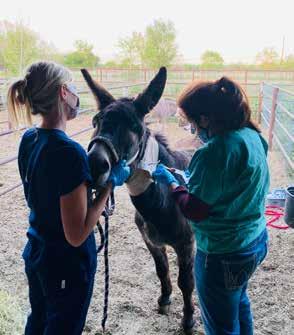
5 minute read
PAIN
Pain Relief for Donkeys
Transdermal Flunixin Meglumine Provides Durable, Safe Pain Relief
By Joy Curzio
Most pain-relief agents for horses are used off label for donkeys even though the pharmacokinetics and pharmacodynamics might be different.
Donkeys often require higher doses and more frequent intervals of medications than horses. Donkeys also have shown greater resistance to swallowing oral medications than horses and can prove to be difficult patients for insertion of IV lines.
Recent research has shown, however, that transdermal administration of flunixin meglumine (Banamine Transdermal solution, Merck Animal Health) may be safe and highly effective for donkeys, providing durable pain relief despite the pharmacokinetic challenges.
“From behavioral and physiological standpoints, pharmacologically, donkeys are not just horses with big ears,” said Amy K. McLean, PhD, an assistant professor in the Department of Animal Science at UC Davis. “The thicker cutaneous colli muscles that cover the jugular vein can be a challenge [for IV administration of pain-relief agents], and even oral applications of various medications can be challenging because you think they have absorbed the medication, but they spit it out when you walk away.”
Dr. McLean led and reported on a small pilot study that found that transdermal flunixin, currently only approved in cattle, was measurable up to 96 hours post-administration compared with 60 hours for the oral and 48 hours for the IV formulations. Previous studies of transdermal flunixin for horses found anti-inflammatory efficacy for 24 to 72 hours. In addition, administration of the transdermal formulation—applied as a liquid from the donkeys’ withers backward toward the tail, until the full dose has been used—resulted in no adverse events.

Finding Cues, Collecting Data
Signs of discomfort and pain in donkeys are discreet. Based on visual cues observed post-castration, donkeys show subtle facial grimacing and orbital tightening, slightly lowered ears, eye blinking and tail swishing when in pain, which are all signs that are easy to miss in the field or go unnoticed in a clinical practice.
Dr. McLean noted that when pain and discomfort can be identified, the next step is to decrease antiinflammatory markers and improve the donkey’s experience. “We’re trying to increase our ability to provide take-home information for the owner so they can continue to actively and progressively treat their patient at home,” she said.
Dr. McLean and colleagues aimed to compare how long flunixin and its metabolite (5OH flunixin) were measurable post-administration for each of the 3 formulations, with a focus on transdermal, and how well each formulation suppressed inflammatory markers (eicosanoids) over time in 6 healthy donkeys.
Catheters were placed to collect urine samples within the first 48 hours post-administration, and then direct venipuncture was used. Twenty-two whole-blood samples were collected over 96 hours post-administration. LC-MS/MS suppression and calcium ionophore testing determined eicosanoid suppression in a second smaller set of whole-blood samples. A 3-way crossover design was used, with a 2-week washout period in between formulations. Doses were 1.1 mg/kg for bodyweight for both the oral and IV formulations, and 3.3 mL/kg for bodyweight for the transdermal, the latter being based on the label recommendation of approximately 1 mL/100 lbs of bodyweight. A noncompartmental analysis was used for statistical determinations (P< 0.05).
Donkeys often require higher and more frequent doses of pain medications than horses.
Building on Promising Results
In addition to the extremely long measurable duration for transdermal flunixin, similar results were seen for duration of its metabolite: 72 hours with IV and 96 hours with both the oral and transdermal formulations. Thromboxane B2 and prostaglandin F2 alpha served as the inflammatory markers for the study.
“What [we noticed] with the transdermal [formulation], there was a slower more gradual reduction in the suppression of thromboxane, starting around 1 hour … and it remained for a longer period, up to 24 hours. There were similar findings regarding prostaglandin F2 alpha, especially for both the oral and IV [formulations], suppressed at 1 hour and stay suppressed until about 8 hours,” she said.
The transdermal formulation also was shown to have a higher half-life compared with the IV formulation.
Although no hair loss or skin redness was seen, Dr. McLean noted that this pilot study only administered 1 dose so further study of multiple dosages and at various dose levels is needed. She also questioned what effect the transdermal formulation could have on the gastrointestinal system and gut microbiome. Dr. McLean encouraged veterinarians who are treating donkeys for pain management to share their experiences in community forums to help obtain more information about this group of patients. MeV
For more information:
McLean A, Falt T, Abdelfattah E, et al. Transdermal flunixin meglumine as a pain relief in donkeys: A pharmacokinetics pilot study. Metabolites. 2023;13(7):776. doi: 10.3390/ metabo13070776. https://www.ncbi.nlm.nih.gov/pmc/ articles/PMC10383245/
Knych HK, Arthur RM, Gretler SR, et al. Pharmacokinetics of transdermal flunixin meglumine and effects on biomarkers of inflammation in horses. J Vet Pharmacol Ther. 2021;44(5):745753. https://onlinelibrary.wiley.com/doi/abs/10.1111/ jvp.12993
Orth E, Navas GF, Pastrana CI, et al. Development of a donkey grimace scale to recognize pain in donkeys (Equus asnius) post castration. Animals. 2020;10:1411. https://www.mdpi. com/2076-2615/10/8/1411







